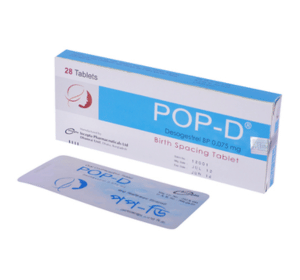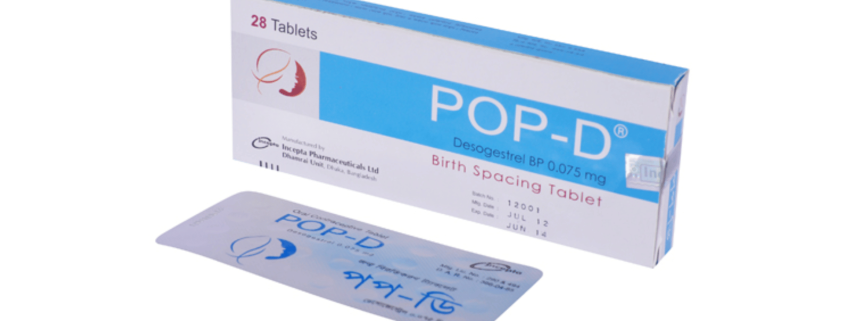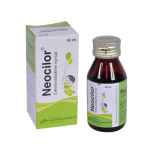POP-D(Desogestrel)

Therapeutic Group: Contraceptive
Presentation
POP-D : Each tablet contains 0.075 mg Desogestrel.
Description
POP-D is a progestogen-only tablet, which contains the progestogen Desogestrel. Like other progestogen-only tablets, POP-D is best suited for use during breast feeding and for women who may not or do not want to use estrogens. In contrast to traditional progestogen-only tablets, the contraceptive effect of POP-D is achieved primarily by inhibition of ovulation. Other effects include increased viscosity of the cervical mucus.
Indications
Prevention of pregnancy.
Dosage & Administration
How to take POP-D
To achieve maximum contraceptive effectiveness, POP-D must be taken in the order directed on the package and at intervals not exceeding 24 hours. Women should be instructed to take the tablets at about the same time every day, preferably after the evening meal or at bedtime. One tablet is to be taken daily for 28 consecutive days. Each subsequent pack is started on the day after the current pack is completed.
1. If you have decided to take POP-D for contraception, wait for your next menstruation begins.
2. From the first day of your menstruation, start taking the first white tablet from the left corner of the top row(with arrow mark) of your POP-D pack.
3. Continue taking one white tablet each day along the arrow mark for consecutive 28 days.
4. After completing the present POP-D pack, start taking another POP-D pack and continue taking the tablet as long as you don\\\’t want to be pregnant.
Following first-trimester abortion
After first-trimester abortion it is recommended to start immediately. In that case there is no need to use an additional method of contraception.
Following delivery or second-trimester abortion
Contraceptive treatment with POP-D after delivery can be initiated before the menstruations have returned. If more than 21 days have elapsed pregnancy ought to be ruled out and an additional method of contraception should be used for the first week.
How to start POP-D when changing from other contraceptive methods
Changing from a combined hormonal contraceptive (combined oral contraceptive (COC), vaginal ring, or transdermal patch).
The woman should start POP-D preferably on the day after the last active tablet (the last tablet containing the active substances) of her previous COC or on the day of removal of her vaginal ring or transdermal patch. In these cases, the use of an additional contraceptive is not necessary.
The woman may also start at the latest on the day following the usual tablet-free, patch-free, ring-free, or placebo tablet interval of her previous combined hormonal contraceptive, but during the first 7 days of tablet-taking an additional barrier method is recommended.
Changing from a progestogen-only-method (minitablet, injection, implant or from a progestogen-releasing intrauterine system [IUS]).
The woman may switch any day from the minitablet (from an implant or the IUS on the day of its removal, from an injectable when the next injection would be due).
Management of missed tablets
Contraceptive protection may be reduced if more than 36 hours have elapsed between two tablets. If the user is less than 12 hours late in taking any tablet, the missed tablet should be taken as soon as it is remembered and the next tablet should be taken at the usual time. If she is more than 12 hours late, she should use an additional method of contraception for the next 7 days. If tablets were missed in the first week and intercourse took place in the week before the tablets were missed, the possibility of a pregnancy should be considered.
Advice in case of gastrointestinal disturbances
In case of severe gastro-intestinal disturbance, absorption may not be complete and additional contraceptive measures should be taken. If vomiting occurs within 3-4 hours after tablet-taking, absorption may not be complete. In such an event, the advice concerning missed tablets is to take another tablet immediately.
Side Effects
Common- Irregular bleeding, amenorrhoea, headache, weight gain, breast pain, nausea, acne, mood changes, decreased libido. Less common- Vaginitis, dysmenorrhea, vomiting, alopecia, fatigue, difficulty wearing contact lenses. Rare- Rash, urticaria, erythema nodosum.
Precautions
POP-D should be discontinued in the event of a thrombosis. If a sustained hypertension develops during the use of POP-D, the discontinuation of POP-D should be considered.
Although progestogens may have an effect on peripheral insulin resistance and glucose tolerance, there is no evidence for a need to alter the therapeutic regimen in diabetics using progestogen-only tablets. However, diabetic patients should be carefully observed during the first months of use.
Use in Pregnancy & Lactation
Pregnancy:
Incase of known or suspected POP-D is contraindicated.
Lactation:
POP-D does not influence the production or the quality (protein, lactose, or fat concentrations) of breast milk. From clinical trial it has been seen that it has no effect on the development and growth of a nursing infant.
Drug Interaction
Drug interactions can occur with medicinal products that induce microsomal enzymes, which can result in increased clearance of sex hormones (such as, hydantoins (e.g. phenytoin), barbiturates (e.g. phenobarbital), primidone, carbamazepine, rifampicin, and possibly also for oxcarbazepine, topiramate, rifabutin, felbamate, ritonavir, nelfinavir, griseofulvin. Hormonal contraceptives may interfere with the metabolism of other drugs. Accordingly, plasma and tissue concentrations may either increase (e.g. cyclosporine) or decrease.
Over Dose
There have been no reports of serious deleterious effects from overdose. Symptoms that may occur in this case are nausea, vomiting and, in young girls, slight vaginal bleeding. There are no antidotes and further treatment should be symptomatic.
Storage
Store below 25 °C in a cool, dry place. Keep away from light & out of reach of children.
Commercial Pack
POP-D : Each blister contains 28 tablets. Each carton contains 1 blister packed separately in a pouch.



